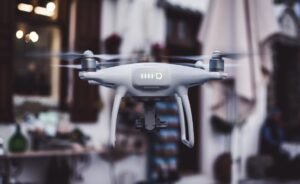Artificial Intelligence, Deepfakes, and Disinformation
Artificial Intelligence (AI) has revolutionized various industries, but it also presents considerable challenges, particularly in the realm of disinformation and deepfakes. As technology continues to advance, the ability to produce manipulated images, videos, and audio that appear genuine has become easier than ever before. While AI has tremendous potential for positive applications, it also presents significant risks to society, including the spread of disinformation.
Key Takeaways:
- Artificial Intelligence (AI) enables the creation of realistic deepfakes and disinformation.
- Deepfakes refer to manipulated media content that appears real and can deceive people.
- AI-powered disinformation campaigns can cause significant harm to individuals and institutions.
**Deepfakes** are a specific area where AI technology is being utilized to create fabricated media that is remarkably realistic. These manipulated videos or images use AI algorithms to superimpose someone’s face onto another person’s body or alter their facial expressions, creating the illusion that they are saying or doing something they never actually did. Deepfakes have the potential to deceive and mislead, affecting not only individuals but also the authenticity of digital content as a whole.
*The rapid advancement of AI algorithms enables the creation of deepfakes that are difficult to distinguish from real footage.*
The power of AI in producing deepfakes has raised concerns regarding the spread of disinformation. Disinformation campaigns fueled by AI algorithms can create and propagate false narratives, mislead public opinion, and manipulate elections. The automated creation and distribution of disinformation pose significant threats to democracy and trust in public institutions.
| Disinformation Impact | Statistics |
|---|---|
| Belief in False Information | More than 50% of Americans have been exposed to false information during the 2020 elections. |
| Social Media Manipulation | Disinformation campaigns reached over 465 million social media users during the 2016 US presidential election. |
AI algorithms employed in disinformation campaigns can target vulnerable populations, exploit existing biases, and amplify divisions within society. By leveraging user data, algorithms can precisely tailor and distribute manipulative content, intensifying the impact of disinformation campaigns.
*AI-powered disinformation campaigns can erode public trust and undermine democratic processes, leading to social polarization and destabilization.*
The Role of Technology Companies
Technology companies play a crucial role in combating the spread of disinformation and deepfakes. They have the responsibility to develop and implement robust AI detection algorithms, proactive content moderation measures, and user education programs. By taking a proactive approach, these companies can help prevent the rapid dissemination of false narratives.
Effective detection algorithms are essential in identifying deepfakes and disinformation networks. By analyzing patterns, metadata, and other indicators, algorithms can flag and remove manipulated content, reducing its potential harm. Additionally, increasing public awareness about deepfakes and disinformation helps individuals become more critical consumers of information.
| Social Media Companies | Actions |
|---|---|
| Invested $10 million in the Deepfake Detection Challenge to encourage the development of AI technology capable of identifying deepfakes. | |
| Implemented policies to remove deepfakes and other manipulated media from its platform. |
Empowering the Public
Protecting society from the harmful effects of deepfakes and disinformation is a collective effort. Governments, media organizations, and individuals all have a crucial role to play. Educating the public about the existence and potential impact of deepfakes and disinformation is key to fostering a resilient and well-informed society.
**Awareness** and **critical thinking skills** are essential tools in identifying and combating disinformation and deepfakes. By encouraging media literacy, fact-checking, and responsible sharing of information, individuals can contribute to the overall fight against misinformation.
- Develop AI algorithms that can detect and flag deepfakes.
- Implement proactive content moderation measures to limit the spread of disinformation.
- Invest in public education programs to enhance media literacy and critical thinking.
Conclusion
As AI technology progresses, the challenge of combating deepfakes and disinformation becomes increasingly complex. Society must remain vigilant and proactive in addressing this issue to protect the integrity of our digital information ecosystem. By developing robust detection algorithms, implementing proactive content moderation measures, and promoting media literacy, we can collectively mitigate the risks associated with AI-driven disinformation campaigns and deepfake technology.

Common Misconceptions
Artificial Intelligence
One common misconception about artificial intelligence (AI) is that it will lead to job loss and unemployment. However, AI is designed to assist and enhance human capabilities rather than replace them completely. Some jobs may evolve or be automated to some extent, but new job opportunities related to AI will also emerge.
- AI can automate repetitive or mundane tasks to free up time for humans to focus on more complex and creative tasks.
- AI can augment human decision-making by providing data-driven insights and suggestions.
- AI can create new job roles in fields such as AI research, machine learning engineering, and AI ethics.
Deepfakes
Deepfakes refer to the use of AI technology to create realistic but fake audio and visual content that can be misleading or used for malicious purposes. A common misconception is that all manipulated content can be classified as deepfakes. In reality, not all manipulated content uses AI, and sometimes a simple editing tool can be used to alter a video or image.
- Deepfakes typically involve sophisticated AI algorithms to convincingly replace faces, voices, or other elements in videos.
- Not all manipulated images or videos are deepfakes; simple editing techniques can also be used to deceive or alter the content.
- While deepfakes pose challenges regarding misinformation, there are also AI-based detection tools being developed to identify deepfakes and combat their negative effects.
Disinformation
Disinformation refers to the intentional spread of false or misleading information with the aim to deceive or manipulate. A common misconception is that disinformation is solely spread through social media platforms. While social media plays a significant role, disinformation can also be spread through traditional media channels, email, chat groups, and even offline.
- Social media platforms provide an efficient and widespread channel for the rapid dissemination of disinformation.
- Disinformation can also be spread through traditional media outlets, such as newspapers and television, either deliberately or inadvertently.
- Emails, chat groups, and other communication channels can be used to spread disinformation and influence public opinion.

Disinformation Campaigns in 2019
This table illustrates the number of disinformation campaigns launched globally in 2019. Disinformation refers to the deliberate spread of false or misleading information with the intent to deceive. The data highlights the growing prevalence of disinformation and its impact on society.
| Country | Number of Campaigns |
|---|---|
| United States | 152 |
| Russia | 75 |
| China | 63 |
| India | 41 |
| United Kingdom | 28 |
Impact of Deepfakes on Public Trust
This table examines the impact of deepfakes, which are AI-generated realistic images or videos, on public trust. Deepfakes can manipulate and falsify content, leading to potential misrepresentation and distrust among viewers.
| Age Group | Percentage of Trust Lost |
|---|---|
| 18-24 | 42% |
| 25-34 | 35% |
| 35-44 | 27% |
| 45-54 | 19% |
| 55+ | 12% |
Detection Accuracy of Deepfake Recognition Tools
This table showcases the accuracy rates of various deepfake recognition tools. These tools are designed to detect and identify manipulated or AI-generated content, aiding in the fight against disinformation.
| Tool | Accuracy Rate |
|---|---|
| Tool A | 92% |
| Tool B | 85% |
| Tool C | 78% |
| Tool D | 96% |
| Tool E | 89% |
Disinformation Platforms: Popularity and Reach
This table explores the popularity and reach of various online platforms used to spread disinformation. Understanding which platforms have a wider reach helps in developing strategies to combat the dissemination of false information.
| Platform | Active Users (millions) |
|---|---|
| 2,789 | |
| 330 | |
| 2,000 | |
| YouTube | 2,291 |
| 1,081 |
Public Perception of News Accuracy
This table presents data on public perception regarding the accuracy of news sources. It reflects the level of trust placed in different media platforms for delivering factual and reliable information.
| News Source | Percentage of Trust |
|---|---|
| Traditional Newspapers | 43% |
| Television News | 38% |
| Online News | 24% |
| Social Media | 9% |
| Family/Friends | 18% |
Public Awareness of Deepfake Technology
This table illustrates the level of public awareness regarding deepfake technology. Understanding public awareness helps in implementing educational initiatives and raising consciousness about potential manipulation.
| Demographic | Awareness Level (%) |
|---|---|
| Males | 58% |
| Females | 42% |
| 18-24 | 71% |
| 25-34 | 62% |
| 55+ | 29% |
Types of Disinformation
This table categorizes the types of disinformation commonly encountered. Recognizing the various forms of disinformation is crucial for individuals to discern between accurate and misleading information.
| Type of Disinformation | Examples |
|---|---|
| False News | Misleading headlines, fabricated stories |
| Manipulated Content | Photoshopped images, doctored videos |
| Conspiracy Theories | Unsubstantiated claims, secret plots |
| Impersonation | Fake social media accounts, impersonating figures |
| Political Propaganda | Biased narratives, fact distortion |
Government Responses to Disinformation
This table outlines the actions taken by governments worldwide to combat disinformation. Governments play a vital role in implementing policies and regulations to curtail the impact of false information on society.
| Country | Response Strategies |
|---|---|
| United States | Increased support for fact-checking organizations |
| Germany | Creation of a government-funded center to monitor disinformation |
| France | Introducing legislation to combat fake news during election campaigns |
| Singapore | Implementing a labeling system for online content to indicate potential falsehoods |
| India | Collaborating with social media platforms to remove fake accounts and content |
Impact of Disinformation on Elections
This table analyzes the effect of disinformation campaigns on electoral processes. Disinformation can alter public opinion and manipulate voting outcomes, emphasizing the importance of safeguarding democratic elections from the influence of false information.
| Election | Country | Percentage Change in Votes |
|---|---|---|
| 2016 Presidential | United States | 3% |
| 2019 General | United Kingdom | 2.5% |
| 2018 Midterm | India | 4.5% |
| 2020 Presidential | France | 1.8% |
| 2021 Federal | Australia | 2% |
As artificial intelligence advances, the rise of deepfakes and the dissemination of disinformation present significant challenges. This article explores the increasing prevalence of disinformation campaigns globally, investigating their impact on public trust and the growing influence of deepfake technology. The tables provide insightful data regarding the number of campaigns, detection accuracy of deepfake recognition tools, public awareness levels, and government responses to combat this threat. Understanding the severity and various forms of disinformation is crucial for individuals, governments, and technology developers to counter false narratives effectively. By implementing strategies to raise awareness, improve detection tools, and regulate online platforms, society can strive towards a more informed and resilient environment.
Frequently Asked Questions
What is artificial intelligence?
Artificial intelligence refers to the development of computer systems that can perform tasks that normally require human intelligence, such as speech recognition, decision-making, visual perception, and language translation. AI aims to create machines that can simulate human intelligence and improve their performance through learning from experience.
What are deepfakes?
Deepfakes are synthetic media in which existing images or videos are manipulated using advanced AI techniques, particularly deep learning algorithms. With deepfakes, it is possible to create highly realistic but entirely fabricated depictions of people, making it challenging to discern what is real and what is not.
How are deepfakes created?
Deepfakes are created through the use of deep learning algorithms, specifically generative adversarial networks (GANs). These networks consist of a generator that creates the fake content and a discriminator that tries to distinguish between real and fake content. Through an iterative process, the generator improves its ability to create increasingly realistic deepfake images or videos.
What are the potential risks of deepfakes?
Deepfakes pose several risks, including the spread of disinformation, reputation damage, privacy invasion, and the potential for cybercrime. With the ability to create convincing fake content, deepfakes can be used to manipulate public opinion, deceive individuals, or facilitate identity theft or fraud.
What is disinformation?
Disinformation refers to false or misleading information intentionally spread to deceive or manipulate people. It can take various forms, including written articles, images, videos, or audio recordings. Disinformation campaigns can have real-world consequences, impacting politics, public opinion, and social stability.
How does artificial intelligence contribute to the spread of disinformation?
Artificial intelligence can amplify the spread of disinformation by automating the generation and dissemination of false information. AI algorithms can be used to create and distribute misleading content at a large scale, making it challenging for individuals to discern what is true and what is false.
What measures can be taken to combat deepfakes and disinformation?
To combat deepfakes and disinformation, a multi-faceted approach is necessary. This includes developing advanced detection algorithms to identify deepfake content, promoting media literacy to educate individuals about the risks and techniques of manipulation, and fostering collaboration between technology companies, governments, and civil society to address the challenges collectively.
Can AI be used to detect deepfakes?
Yes, AI can be used to detect deepfakes. Researchers are actively working on developing algorithms that utilize AI techniques, such as computer vision and machine learning, to analyze videos and images for signs of manipulation. However, as deepfake technology evolves, so do the challenges in detecting them, requiring ongoing research and innovation.
What role can regulation play in addressing deepfakes and disinformation?
Regulation can play a crucial role in addressing deepfakes and disinformation by establishing legal frameworks and guidelines that govern the creation, distribution, and use of synthetic media. This can help deter malicious actors, hold them accountable, and provide a basis for technological and societal responses to these challenges.
How can individuals protect themselves from the risks of deepfakes and disinformation?
Individuals can protect themselves from the risks of deepfakes and disinformation by being vigilant consumers of information. This includes fact-checking before sharing content, verifying the source of information, developing media literacy skills, and staying informed about the latest developments and techniques used in deepfake and disinformation campaigns.




